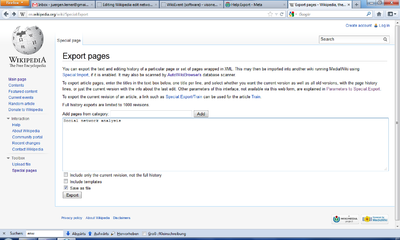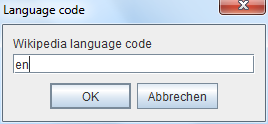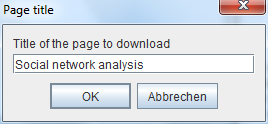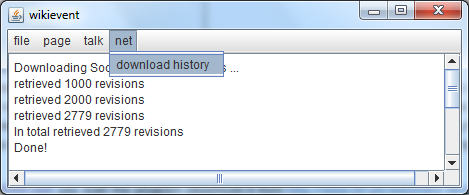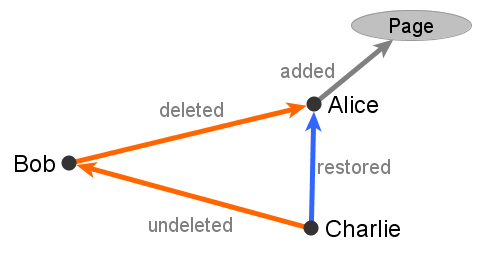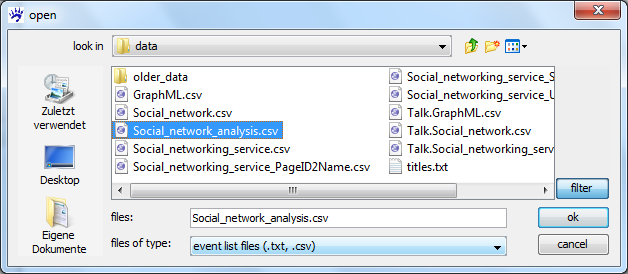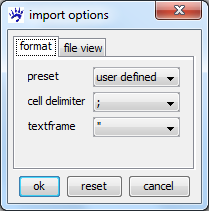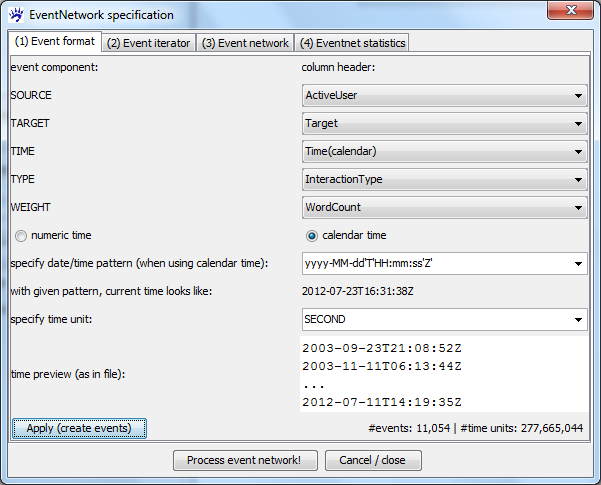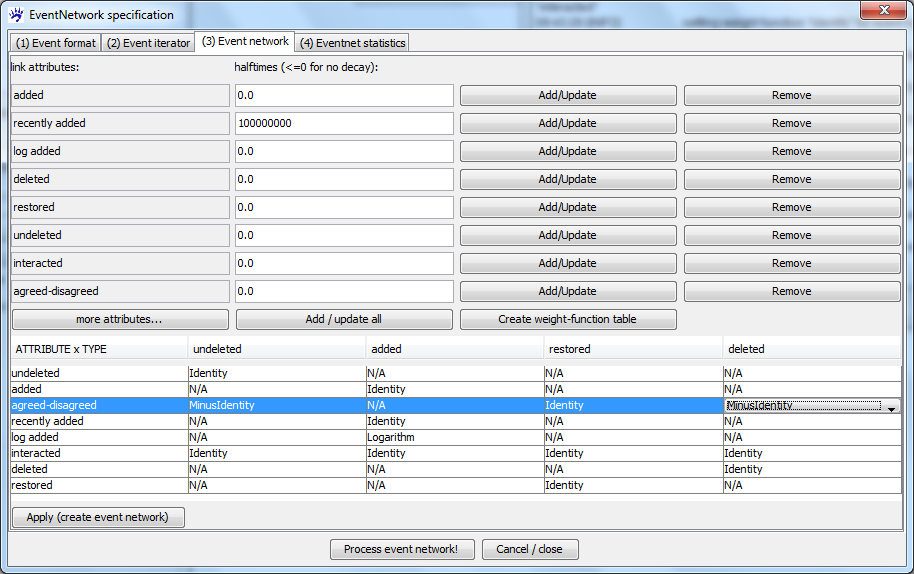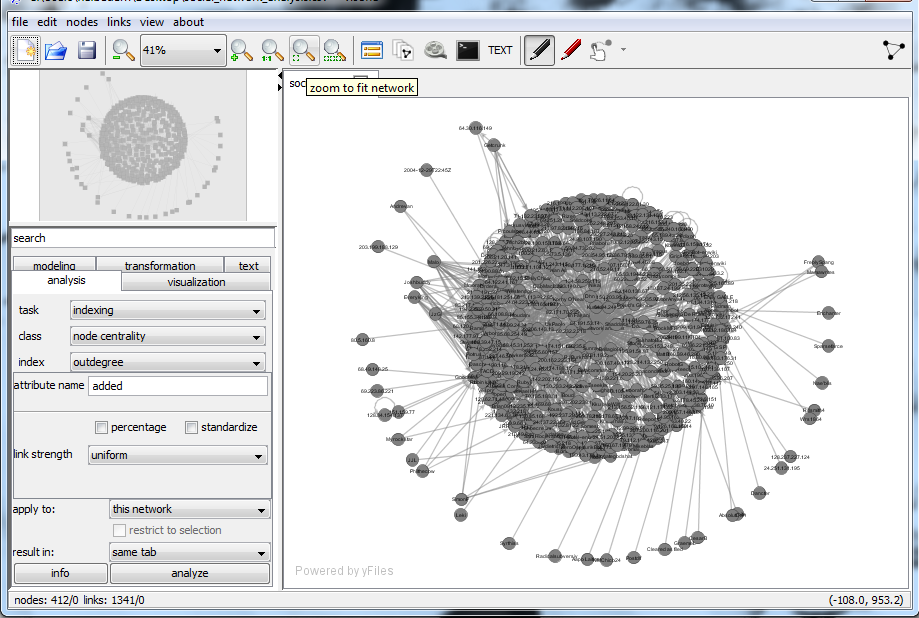Wikipedia edit networks (tutorial): Difference between revisions
| Line 148: | Line 148: | ||
The created network snapshots have nodes representing the page (or pages, if there are several in the history file) and all users that contributed at or before the time of the snapshot. The link attributes encode (in our case) the number of words added, deleted, restored, undeleted, or modifications thereof (as explained before) - again taken at the snapshot time. Analysis and visualization works similar as for any other network with many numerical link attributes. In particular, many of the derived user attributes that have been proposed in Ulrik Brandes, Patrick Kenis, Jürgen Lerner, and Denise van Raaij: [http://www.inf.uni-konstanz.de/algo/publications/bklv-nacsw-09.pdf '''Network Analysis of Collaboration Structure in Wikipedia''']. Proc. 18th Intl. World Wide Web Conference (WWW 2009) can be computed and visualized by visone starting from the available link attributes. Examplarily we illustrate some possibilities with the first snapshot, the smallest one, that has 412 nodes and 1341 links. | The created network snapshots have nodes representing the page (or pages, if there are several in the history file) and all users that contributed at or before the time of the snapshot. The link attributes encode (in our case) the number of words added, deleted, restored, undeleted, or modifications thereof (as explained before) - again taken at the snapshot time. Analysis and visualization works similar as for any other network with many numerical link attributes. In particular, many of the derived user attributes that have been proposed in Ulrik Brandes, Patrick Kenis, Jürgen Lerner, and Denise van Raaij: [http://www.inf.uni-konstanz.de/algo/publications/bklv-nacsw-09.pdf '''Network Analysis of Collaboration Structure in Wikipedia''']. Proc. 18th Intl. World Wide Web Conference (WWW 2009) can be computed and visualized by visone starting from the available link attributes. Examplarily we illustrate some possibilities with the first snapshot, the smallest one, that has 412 nodes and 1341 links. | ||
The first observation is that the layout after loading is very cluttered. Actually, all user-nodes that added at least one word to the page (''Social network analysis'') are at a distance of two or smaller - leading to the very dense circle around one very central node. An improvement can be achieved by deleting the node representing the page - after some information has been collected in the (user-)nodes. Therefore, go to the [[analysis tab]] select the node outdegree with ''link strength'' set to the link attribute ''added'' and save it in a node attribute ''added'' (see the screen shot below). | The first observation is that the layout after loading is very cluttered. Actually, all user-nodes that added at least one word to the page (''Social network analysis'') are at a distance of two or smaller - leading to the very dense circle around one very central node. An improvement can be achieved by deleting the node representing the page - after some information has been collected in the (user-)nodes. Therefore, go to the [[analysis tab]] select the node outdegree with ''link strength'' set to the link attribute ''added'' and save it in a node attribute ''added'' (see the screen shot below). Do the same again with the attribute ''log added''. | ||
[[File:Eventnet_outdegree_added.png]] | [[File:Eventnet_outdegree_added.png]] | ||
To delete the single node representing the page we have to select it first. This can be done by selecting the single node with the label equal to ''Social network analysis'' in the [[node selection dialog]]; or (more generally since it is applicable to networks with several page-nodes) we compute the unweighted outdegree and select all nodes with outdegree equal to zero - these are exactly the nodes representing pages. | |||
== Statistical modeling of edit event networks == | == Statistical modeling of edit event networks == | ||
Revision as of 12:10, 24 July 2012
The edit network associated with the history of Wikipedia pages is a network whose nodes are the page(s) and all contributing users and whose edges encode time-stamped, typed, and weighted interaction events (edit events) between users and pages and between users and users. Specifically, edit events encode the exact time when an edit has been done along with one or several of the following types of edit interaction:
- the amount of new text that a user adds to a page;
- the amount of text that a user deletes (along with the other user/s that has/have previously added this text);
- the amount of previously deleted text that a user restores (along with the users that previously deleted and the ones that originally added the text).
Together these edit events form a highly dynamic network revealing the emergent collaboration structure among contributing users. For instance, it can be derived
- who are the users that contributed most of the text;
- what are the implicit roles of users (e.g., contributors of new content, vanalism fighters, watchdogs);
- whether there are opinion groups, i.e., groups of users that mutually fight against each others edits.
This tutorial is a practically oriented "how-to"-guide giving an example based introduction to the computation, analysis, and visualization of Wikipedia edit networks. More background can be found in the papers cited in the references. To follow the steps outlined here (or to do a similar study) you should download WikiEvent - a small graphical java software with which the Wikipedia edit networks can be computed.
How to download the edit history?
Wikipedia not only provides access to the current version of each page but also to all of its previous versions. To view the page history in your browser you can just click on the history link on top of each page and browse through the versions. However, for automatic extraction of edit events we need to download the complete history in a more structured format. To do this there are various possibilities that are appropriate in different scenarios (and dependent on your computational resources and internet bandwidth).
To get the history of all pages you can go to the Wikimedia database dumps, select the wiki of interest (for instance, enwiki for the English-language Wikipedia), and download all files linked under the headline All pages with complete edit history. The complete database is extremely large (several terabytes for the English-language Wikipedia) and probably cannot be managed with an ordinary desktop computer.
Another possibility to get the complete history of a Wikipedia page (or of a small set of pages) is to use the wiki's Export page. The preceeding link is for the English-language Wikipedia - for other languages just change the language identifier en in the URL to, for instance, de or fr or es, etc. (Actually, this visone wiki has, as any other MediaWiki, also an export page available at Special:Export; there you could download the edit history of visone manual pages - which are definitively much shorter than those from Wikipedia.)
For instance, to download the history of the page Social network analysis make settings as in the screenshot above and click on the Export button. However, as it is noted on the page, exporting is limited to 1000 revisions and the example page (Social network analysis) has already more than 2700 revisions. In principle it is possible to download the next 1000 revisions by specifying an appropriate offset (as explained on the manual page for Special:Export) and then pasting the files together. However, since this is rather tedious the software WikiEvent offers a possibility to do this automatically. (Internally WikiEvent proceeds exactly as described above by retrieving revisions in chunks of 1000 and appending these to a single output file.)
To download a page history with WikiEvent you start the program (download it from http://www.inf.uni-konstanz.de/algo/software/wikievent/ and execute by double-clicking) and click on the entry download history in the net menu. You have to specify the language of the Wikipedia (for instance, en for English, de for German, fr for French, etc), the title of the page to download and a directory on your computer in which the file should be saved.
The program is actually very silent - for instance, you don't see a progres bar - until the download is complete. The time it takes to download depends on many factors, among them the size of the page history (which might be several gigabytes for some popular pages!) and the bandwidth of your internet connection. At the end you see the number of downloaded revisions in the message area of WikiEvent.
For information: the size of the history file for the page Social network analysis is about 83 Megabytes on July 20, 2012 (obviously growing). The history is saved in a file Social_network_analysis.xml in the directory that you have chosen. If you are interested, the XML format is described in the page http://meta.wikimedia.org/wiki/Help:Export - but you never have to read these files since they are automatically processed as described below.
Computing the edit network
To compute the edit events from a Wikipedia history file select the entry extract edit events in the page-menu of WikiEvent. You have to specify one or more history file(s) and a directory to save the files with the edit events. (These output files have the same names as the input files - just with the ending .xml replaced by .csv.)
If we compute the edit events from the history of the page Social network analysis, then the first few lines of the edit event file look like this:
PageTitle;RevisionID;Time(calendar);Time(milliseconds);InteractionType;WordCount;ActiveUser;Target "Social network analysis";1711088;2003-09-23T21:08:52Z;1064344132000;added;196;"142.177.104.40";"Social network analysis" "Social network analysis";2002109;2003-11-11T06:13:44Z;1068527624000;added;10;"63.228.105.175";"Social network analysis" "Social network analysis";2002109;2003-11-11T06:13:44Z;1068527624000;deleted;192;"63.228.105.175";"142.177.104.40" "Social network analysis";2036847;2003-12-19T22:42:43Z;1071870163000;added;54;"Davodd";"Social network analysis" "Social network analysis";2036847;2003-12-19T22:42:43Z;1071870163000;deleted;7;"Davodd";"63.228.105.175" "Social network analysis";2210638;2003-12-24T13:29:11Z;1072268951000;added;1;"210.49.82.219";"Social network analysis" "Social network analysis";2210638;2003-12-24T13:29:11Z;1072268951000;deleted;1;"210.49.82.219";"Davodd" ...
The file encodes a table with entries separated by semicolons (;). The columns from left to right encode
- The title of the page (since a history file can contain the history of several pages the title-field can actually vary.).
- The revision id which is a number uniquely identifying a revision in Wikipedia (not just in one page). A single edit can produce more than just one line in the output file (we say more on this below); the revision id makes it possible to recognize which lines belong to the same edit.
- The time of the edit given as a date/time-string. For instance the first edit happend on September 23, 2003 at 21:08:52 (where time is measured in the UTC time zone).
- Once again the edit time given as a number encoding milliseconds since January 1, 1970 at 00:00:00.000 Greenwich Mean Time. (This value is actually obtained by the method
getTimeInMillisof the java classCalendar.) The time in milliseconds is helpful if you just need the time difference between revisions and not the actual time or date; it is obvisously easier to compute the time difference from numbers than from data/time strings. - The edit type which can be added, deleted, restored, or undeleted; we say more on this below.
- The word count, i.e., the number of words that are added, deleted, restored, or undeleted with respect to the given target.
- The active user is the user that has done the edit; it is the source node of the edit event. The user is identified by a user name if logged in; otherwise (if it is an anonymous edit) the user is identified by an IP address.
- The target node of the edit event is either the page or a user. If the event type is added, then the target is the page (the active user adds text to the page). If the event type is deleted, restored, or undeleted, then the target is the user who has previously written or deleted the text (the active user deletes/restores/undeletes text that has been added/deleted by the target user).
We say more on the different event types in the following.
The structure of edit network data
Consider an example of three revisions on one page where
- (in Revision 1) user Alice adds some new text to the page;
- subsequently (in Revision 2), user Bob deletes this text;
- then (in Revision 3), user Charlie reverts Bob's edit - setting back the page text to the one submitted in Revision 1.
These three edits together give rise to four dyadic edit events (shown in the image below):
- An edit event of type added from user Alice to the edited page.
- An edit event of type deleted from user Bob directed to user Alice.
- An edit event of type restored from user Charlie directed to user Alice (Charlie restored text that has been previously written by Alice).
- An edit event of type undeleted from user Charlie directed to user Bob (Charlie restored text that has been previously deleted by Bob). Note that after the revert the restored text is (again) authored by Alice and not by Charlie.
All edit events are weighted by the number of words that have been added, deleted, restored, or undeleted and all edit events have a time stamp marking the time when the edit has been submitted.
A single edit on a Wikipedia page generates one hyperedge linking the active user to (potentially) several other users and the edited page. Such a hyperedge has been turned into several lines of the CSV file, each encoding one (dyadic) edge, linking the source (active user) to one target in one interaction type. Note that the hyperedges can be reconstructed from the data using the revision ids (see above).
For determining the amount of text modified in an edit we make some choices. For instance, if complete sentences are just moved from one part of the page to another, we do not count this as any change. More detailed information about the text-processing conventions can be found in
- Ulrik Brandes, Patrick Kenis, Jürgen Lerner, and Denise van Raaij: Network Analysis of Collaboration Structure in Wikipedia. Proc. 18th Intl. World Wide Web Conference (WWW 2009).
and more technically in
- Ulrik Brandes, Patrick Kenis, Jürgen Lerner, and Denise van Raaij: Computing Wikipedia Edit Networks. Technical Report, 2009.
Importing edit event networks into visone
Note: this section describes a fuctionality that will be in the next visone release (around September 2012).
The CSV file with the computed edit events can be imported in visone when opening it as an event list file. Visone's capabilities in importing and analyzing event networks are documented in the tutorial on event networks; here we treat the special case of edit event networks.
To open an event list file (such as the newly created Social_network_analysis.csv) click on open in visone's file menu, select files of type: event list files, navigate to the CSV file, and click on ok. In the import options, choose the semicolon (;) as a cell delimiter and double quotes (") as textframe.
visone can now read the various entries of the input file - and you have to specify how these should be mapped to the resulting network in the dialog EventNetwork specification (shown below). Concretely you have to specify how the various components of an event are encoded in the file (Event format tab); how to iterate over the network sequence (Event iterator tab); how the events are mapped to the network's link attributes (Event network tab); and, if desired, which statistics should be computed while constructing the event network (Eventnet statistics tab). The tabs should be filled out in the order as they are numbered in the dialog since choice-possibilities for the latter tabs depend on previous settings. If you make changes in some tab you have to subsequently set (again) the values for the latter tabs.
Event format
In the event format tab (see the image below) you first have to specify which columns of the input file hold the information about the five components of an event (source, target, time, type, and weight). You can set the values as in the image below.
After these five components have been chosen visone needs some information about the interpretation of time. (visone can handle very general date/time formats - but some information is necessary.) The first choice is the selection between numeric time (if the time fields correspond to integer numbers) or calendar time (if time fields can somehow, specified below, be turned into a date/time). We have calendar time in our example.
If time is given by calendar, a time format pattern has to be specified. visone proposes some known pattern - among others the pattern yyyy-MM-dd'T'HH:mm:ss'Z' which is appropriate for the Wikipedia edit times. You can enter other than the proposed patterns in the textfield if date/time is formatted differently (see the webpage on the java class SimpleDateFormat for guidance). visone assists you in finding the right pattern by showing some date/time strings as they appear in the file and - whenever you select a date format pattern - the dialog shows you the current time formatted by the specified pattern.
Finally, you have to specify a time unit. If time is numeric you have to enter a (integer) number in the textfield. If time is given by calendar you can select a "natural" time unit from Millisecond to Year. An appropriate time unit makes the iteration over the event sequence (and potentially the decay of link attributes over time) more intuitive. When computing event network statistics, events that happen within the same time unit are treated as independent of each other. The finest time unit that makes sense for the Wikipedia edit events is Second (since the edit times are not given with higher precision). But you could also choose Day as a time unit if you think that this is fine-grained enough.
When all settings in the event format tab are done, you can create the list of events by clicking on the Apply (create events) button. A message informs about the number of events and the number of time units from the first to the last event.
Event iterator
In the event iterator tab (see below) you have to specify the start and end time of the time interval to be processed and the delay between network snapshots.
When the networks have been created after filling out the event format tab (see the preceeding section) visone suggests as start time the time of the first event and as end time the time of the last event. If you don't want to process the whole event sequence you can increase the start time and/or decrease the end time. After clicking on the upper Apply / get info button, visone informs you about the number of events and time units in the specified subsequence. You might just take all events by not changing the interval borders; this includes all events from September 23, 2003 to July 11, 2012 - as can be seen in the dialog.
Then you have to choose the time points when a network snapshot is to be created by specifying the delay between snapshots. You can see in the dialog that the event sequence spans more than 277 million time units (i.e., seconds with the current settings). The number of snapshots must be small (some 10 or 20 snapshots would still be ok), since they are all opened in a new tab in visone. When specifying: create snapshots after every 100,000,000 time unit(s), then visone creates three snapshots. (This is an example where a coarser time unit might be more intuitive; 100 million seconds are actually a bit more than 1157 days.) visone always creates one snapshot at the end of the event sequence - even if the waiting time is less than the specified number.
Event network
The tab to specify the event network is the most important one - here you define which link attributes of the event network summarize the past events, how events of various types add to these attributes, and how they change over time. The dialog might seem a bit complicated at first glance but the mechanism to specify the evolution of the event network is very powerful and general.
The first thing to do is to decide on the link attributes. Here you are free to choose any attribute name (that makes it easy to remember the intuition of the attribute). Furthermore, a halftime - defining how fast attributes decay over time - has to be specified. The halftime has the following effect: when a particular link attribute on a particular dyad (pair or actors) has a value of at time , then (if no event on the same dyad happens in between) the value is at time . Intuitively, link attributes with a positive halftime capture recent interaction. A halftime equal to zero or negative indicates that the respective attribute does not decay over time; these attributes capture past interaction irrespective of the elapsed time.
In our concrete example we choose the following link attributes.
- The attributes added, deleted, restored, and undeleted just add up the weight (i.e., the number of words modified) of past events of the respective type (with no decay). For instance, the value of the attribute added on a link connecting user U with page P at time t is equal to the number of words that U contributed to P at or before time t. Similarly, the value of deleted on a dyad (U,V) is equal to the number of words that user U deleted of text previously written by user V.
- The attribute recently added counts words added by users to a page but has a decay over time. If we choose as halftime the same value as for the interval between snapshots, then 100 words added just at the end of the first interval (say) contribute with a value of 50 at the end in the second snapshot. (It is also possible to introduce attributes like recently deleted, etc; and it would also be possible to have varying halftimes to capture very recent interaction, recent interaction, more distant interaction, etc., in the same event network.)
- The attribute log added adds up the logarithm of the number of newly contributed words. A logarithmic transformation is appropriate in very skewed event weights (when, say, twice the number of words should not count twice as much but only slighly more). Other transformations of event weights are also possible.
- The attribute interacted adds up the number of modified (added, deleted, restored, or undeleted) words irrespective of the event type.
- The attribute agreed-disagreed is meant as a proxy for whether a user agrees or rather disagrees with the edits of another user. Specifically, deletions and undeletions are interpreted as disagreements since a user makes another user's edits undone; restoring text is interpreted as an agreement. (This indicator is proposed and used in the published papers cited in the references but will also become clearer in this tutorial.)
At the beginning the dialog has two rows for two different link attributes; more can be added by clicking the more attributes ... button. When all attributes are specified they have to be added to the event network (for instance by clicking the Add / update all button). Then you can create the weight function table.
In the weight function table there is one column for every event type and one row for every link attribute. A particular entry in this table specifies how events of the column type contribute to the link attribute in the respective row. The entries are combo boxes allowing you to select from the available weight functions. For instance, selecting the weight function Identity for the attribute deleted and the event type deleted implies that the weight (i.e., the number of words) of events of type deleted are added (without transforming them) to the link attribute deleted. The weight function Logarithm for the attribute log added and the event type added implies that the logarithm of the event weight is added. Note that in the row corresponding to the attribute interacted we add up the weights of all event types; for the attribute agreed-disagreed we add weights of events of type restored and subtract (chose the weight function MinusIdentity) weights of events of type deleted or undeleted.
When these settings are complete you can process the event network. (You need to fill out the event statistics tab only when you want to do a statistical analysis of the event network - this is documented in a latter section: Wikipedia_edit_networks_(tutorial)#Statistical_modeling_of_edit_event_networks.) After clicking on the button Process event network! it takes a few minutes or so (depending on the size and number of the snapshots). With our settings we create three network tabs holding the three snapshots. The dialog does not close after processing; you might change some of the settings and create different snapshots - or close the dialog explicitly.
Analysis and visualization of edit networks
The created network snapshots have nodes representing the page (or pages, if there are several in the history file) and all users that contributed at or before the time of the snapshot. The link attributes encode (in our case) the number of words added, deleted, restored, undeleted, or modifications thereof (as explained before) - again taken at the snapshot time. Analysis and visualization works similar as for any other network with many numerical link attributes. In particular, many of the derived user attributes that have been proposed in Ulrik Brandes, Patrick Kenis, Jürgen Lerner, and Denise van Raaij: Network Analysis of Collaboration Structure in Wikipedia. Proc. 18th Intl. World Wide Web Conference (WWW 2009) can be computed and visualized by visone starting from the available link attributes. Examplarily we illustrate some possibilities with the first snapshot, the smallest one, that has 412 nodes and 1341 links.
The first observation is that the layout after loading is very cluttered. Actually, all user-nodes that added at least one word to the page (Social network analysis) are at a distance of two or smaller - leading to the very dense circle around one very central node. An improvement can be achieved by deleting the node representing the page - after some information has been collected in the (user-)nodes. Therefore, go to the analysis tab select the node outdegree with link strength set to the link attribute added and save it in a node attribute added (see the screen shot below). Do the same again with the attribute log added.
To delete the single node representing the page we have to select it first. This can be done by selecting the single node with the label equal to Social network analysis in the node selection dialog; or (more generally since it is applicable to networks with several page-nodes) we compute the unweighted outdegree and select all nodes with outdegree equal to zero - these are exactly the nodes representing pages.
Statistical modeling of edit event networks
Specifying event statistics in the eventnet dialog
Computing simple edit events
The discussion network
References
Published papers that propose and/or make use of Wikipedia edit networks include the following.
- Jürgen Lerner, Ulrik Brandes, Patrick Kenis, and Denise van Raaij: Modeling Open, Web-based Collaboration Networks: The Case of Wikipedia. In Markus Gamper, Linda Reschke, Michael Schönhuth (Eds.): Knoten und Kanten 2.0, pp 141-162. transcript-Verlag, 2012.
- Jürgen Lerner, Patrick Kenis, Denise van Raaij and Ulrik Brandes: Will they stay or will they go? How network properties of WebICs predict dropout rates of valuable Wikipedians. European Management Journal, 29(5):404-413, 2011.
- Ulrik Brandes, Patrick Kenis, Jürgen Lerner, and Denise van Raaij: Network Analysis of Collaboration Structure in Wikipedia. Proc. 18th Intl. World Wide Web Conference (WWW 2009).
More technical details about the computation of Wikipedia edit networks can be found in
- Ulrik Brandes, Patrick Kenis, Jürgen Lerner, and Denise van Raaij: Computing Wikipedia Edit Networks. Technical Report, 2009.
